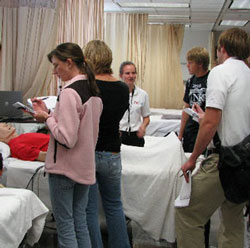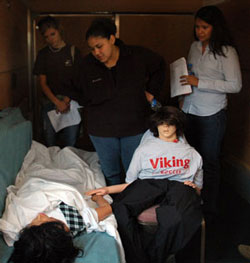 |
Kearney students listen as Beth Beam, center, explains Sim Man’s symptoms. |
 |
Scottsbluff students check out the conditions of three victims in the HEROES mobile simulation unit. |
The purpose of Simulation Day was to expose students to emergency preparedness concepts, said Beth Beam, project coordinator for the College of Nursing’s Programs of Excellence Biopreparedness Grant — which also is known as Healthcare and Emergency Responders Organization Education through Simulation or HEROES.
Six different activities were used to stimulate the students’ curiosity about public health strategies in response to disaster, emergencies and bioterrorism. In addition to Beam, HEROES team members Stephen Smith and Patti Carstens and faculty and staff from both campuses also helped with activities.
The 50 senior level Kearney Division students and 114 Scottsbluff students rotated through six stations,
Stations highlighted:
- Personal preparedness;
- A virtual tour of the biocontainment unit at UNMC in Omaha;
- Assessment of a simulation mannequin patient who was exposed to a biological/chemical agent;
- Review of a biological and chemical agent guide;
- Review of a psychological first aid document; and
- Access to the HEROES Web site.
All nursing students have access to the HEROES Web site and can continue using the site once they graduate.
While working on the HEROES Web site, students were able to begin building a family communication plan and review first aid and emergency supply kits.
“There has been a dramatic shift to public health infrastructure and education in recent years,” Beam said. “Nurses have the potential to make a tremendous impact as the largest group of licensed health professionals in the United States. The NCLEX test plan content includes concepts such as disaster planning, emergency response plan and handling of hazardous and infectious materials. We must prepare our students for both their competency examinations and their future roles as nurses.”